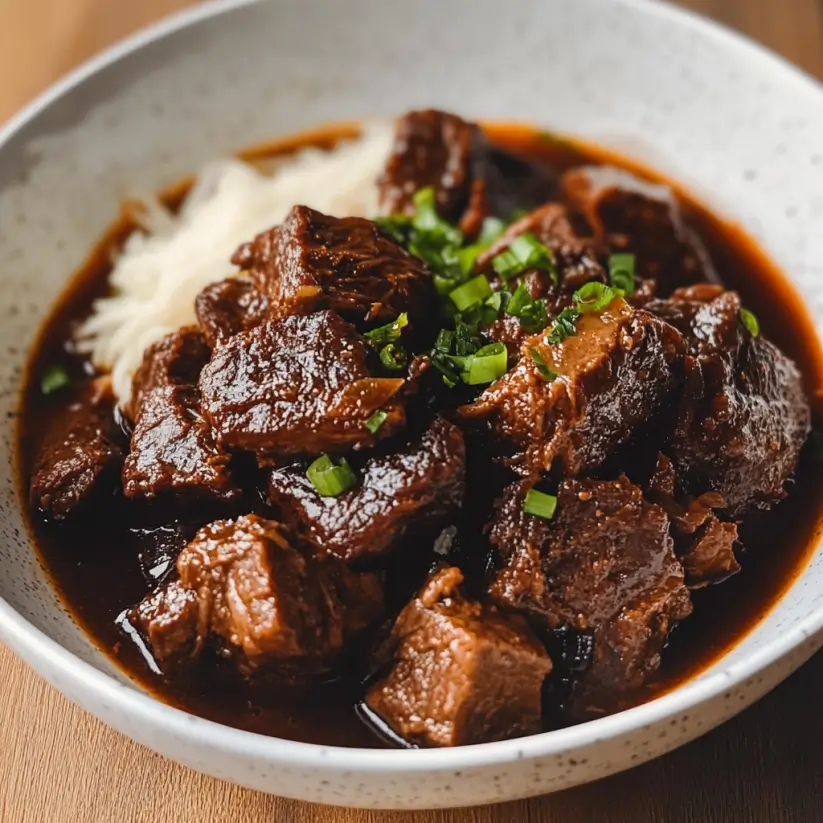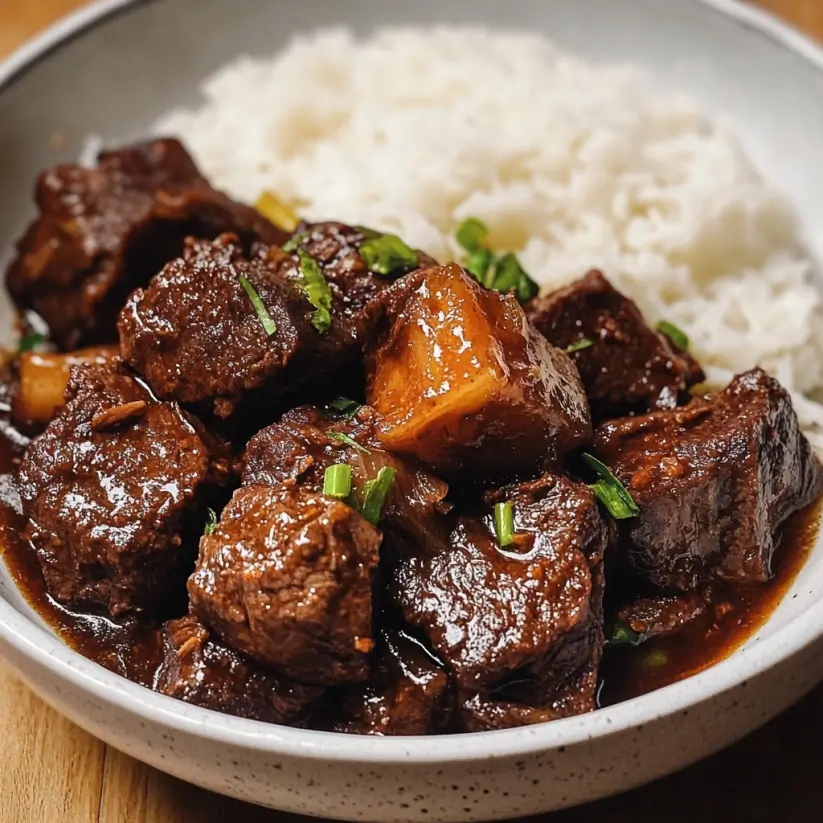
Introduction to Filipino Beef Adobo
When I think of comfort food, Filipino Beef Adobo always comes to mind. This dish is a warm hug on a plate, perfect for those busy weeknights or when you want to impress your loved ones with minimal effort. The savory and tangy flavors meld together beautifully, creating a meal that feels both special and homey.
Whether you’re a seasoned cook or just starting out, this recipe is straightforward and rewarding. With just a few ingredients, you can whip up a dish that’s rich in flavor and tradition. Let’s dive into this culinary adventure together!
Why You’ll Love This Filipino Beef Adobo
Filipino Beef Adobo is a game-changer for your dinner routine.
It’s not just about the incredible taste; it’s also about the ease of preparation.
With minimal hands-on time, you can let the flavors develop while you tackle other tasks.
Plus, the leftovers? They taste even better the next day!
This dish is a surefire way to impress family and friends without breaking a sweat.
Ingredients for Filipino Beef Adobo
Creating the perfect Filipino Beef Adobo starts with gathering the right ingredients.
Here’s what you’ll need:
- Beef Chuck: This cut is ideal for slow cooking, becoming tender and flavorful as it simmers.
- Soy Sauce: Adds a savory depth, balancing the tanginess of the vinegar.
- Vinegar: White or apple cider vinegar brings that signature tang, essential for authentic adobo.
- Water: Helps to create the sauce, ensuring the beef stays moist during cooking.
- Vegetable Oil: Used for sautéing, it adds a subtle richness to the dish.
- Onion: Sliced onions provide sweetness and depth, enhancing the overall flavor.
- Garlic: Minced garlic infuses the dish with aromatic goodness, making it irresistible.
- Bay Leaves: These leaves add a fragrant note, elevating the dish’s complexity.
- Black Peppercorns: Whole peppercorns give a gentle heat and a burst of flavor.
- Brown Sugar (optional): A touch of sweetness can balance the acidity, but it’s entirely up to your taste.
- Salt: Essential for seasoning, adjust to your preference.
- Chopped Green Onions (optional): For garnish, they add a fresh crunch and a pop of color.
For exact measurements, check the bottom of the article where you can find everything listed for easy printing.
Feel free to experiment with these ingredients, as Filipino Beef Adobo is versatile and can be tailored to your liking!
How to Make Filipino Beef Adobo
Making Filipino Beef Adobo is a straightforward process that rewards you with a dish bursting with flavor.
Let’s break it down step by step, ensuring you have all the tips you need for success.
Step 1: Marinate the Beef
Start by placing your beef chuck in a large bowl.
Pour in the soy sauce, vinegar, and water, then toss in the bay leaves and black peppercorns.
Mix everything well, ensuring the beef is coated.
Let it marinate for at least 30 minutes, or even overnight if you have the time.
This step is crucial for infusing the meat with that signature adobo flavor.
Step 2: Sauté the Onions
Heat the vegetable oil in a large pot or Dutch oven over medium heat.
Once hot, add the sliced onions and sauté them until they turn translucent, about 3-4 minutes.
This step builds a flavorful base for your dish, so don’t rush it!
Step 3: Add Garlic
Next, toss in the minced garlic and sauté for another minute.
You want to cook it just until it becomes fragrant.
Be careful not to burn it, as burnt garlic can turn bitter and ruin your dish.
Step 4: Brown the Beef
Remove the beef from the marinade, but don’t discard that liquid gold just yet!
Add the beef to the pot and brown it on all sides, which should take about 5-7 minutes.
This step adds depth to the flavor, creating a nice crust on the meat.
Step 5: Simmer the Dish
Now, pour the reserved marinade into the pot and bring it to a boil.
Once boiling, reduce the heat to low, cover, and let it simmer for about 1.5 to 2 hours.
Stir occasionally, and if the sauce thickens too much, add a splash of water.
This slow cooking process is what makes the beef tender and flavorful.
Step 6: Final Touches
After simmering, taste your adobo and adjust the seasoning.
If you like a hint of sweetness, stir in the brown sugar.
Serve your Filipino Beef Adobo hot over steamed rice, garnished with chopped green onions for that fresh touch.
Enjoy the fruits of your labor, and watch your loved ones savor every bite!

Tips for Success
- Marinate the beef overnight for deeper flavor.
- Use a heavy pot or Dutch oven for even cooking.
- Don’t rush the browning process; it adds flavor.
- Adjust the vinegar to your taste for a milder or tangier dish.
- For a spicier kick, add whole dried chili peppers while simmering.
Equipment Needed
- Large Bowl: For marinating the beef. A mixing bowl works too.
- Pot or Dutch Oven: Essential for simmering. A heavy skillet can also do the job.
- Wooden Spoon: For stirring. A spatula is a good alternative.
- Measuring Cups: To ensure accurate ingredient amounts.
Variations of Filipino Beef Adobo
- Chicken Adobo: Swap beef for chicken thighs or drumsticks for a lighter version that’s equally delicious.
- Pork Adobo: Use pork shoulder or belly for a richer flavor and a different texture.
- Vegetarian Adobo: Replace meat with tofu or tempeh, marinating them in the same sauce for a plant-based twist.
- Adobo sa Gata: Add coconut milk to the simmering sauce for a creamy, tropical flavor.
- Spicy Adobo: Incorporate sliced jalapeños or chili flakes for an extra kick that spice lovers will enjoy.
Serving Suggestions for Filipino Beef Adobo
- Steamed Rice: Serve over fluffy white rice to soak up the savory sauce.
- Pickled Vegetables: A side of pickled vegetables adds a refreshing crunch.
- Cold Beer: Pair with a cold beer or a light Filipino drink like Tanduay.
- Presentation: Garnish with chopped green onions for a pop of color.
FAQs about Filipino Beef Adobo
As you embark on your culinary journey with Filipino Beef Adobo, you might have a few questions. Here are some common queries that can help you navigate this delicious dish:
What makes Filipino Beef Adobo different from other adobo dishes?
Filipino Beef Adobo stands out due to its unique combination of soy sauce and vinegar, creating a savory and tangy flavor profile. While other cultures have their versions of adobo, the Filipino style often includes marinating the meat for deeper flavor and slow cooking for tenderness.
Can I use other meats for this recipe?
Absolutely! While beef is traditional, you can easily substitute chicken or pork. Just adjust the cooking time accordingly, as chicken cooks faster than beef.
How do I store leftovers of Filipino Beef Adobo?
Leftovers can be stored in an airtight container in the refrigerator for up to 3 days. The flavors actually deepen over time, making it even more delicious the next day!
Can I make Filipino Beef Adobo in a slow cooker?
Yes! You can adapt this recipe for a slow cooker. Simply marinate the beef, sauté the onions and garlic, then transfer everything to the slow cooker. Cook on low for 6-8 hours for tender, flavorful results.
What should I serve with Filipino Beef Adobo?
Filipino Beef Adobo pairs wonderfully with steamed rice, pickled vegetables, or even a side salad. A cold beer or a refreshing drink can also complement the meal perfectly!
Final Thoughts
Cooking Filipino Beef Adobo is more than just preparing a meal; it’s about creating memories.
The aroma that fills your kitchen as it simmers is enough to make anyone’s mouth water.
Each bite is a delightful blend of savory and tangy flavors, transporting you to the heart of Filipino cuisine.
Whether you’re sharing it with family or enjoying it solo, this dish brings warmth and comfort.
So, roll up your sleeves, embrace the process, and savor the joy that comes from making this authentic recipe.
Your taste buds will thank you, and so will your loved ones!
Filipino Beef Adobo: Discover the Authentic Recipe!
Ingredients
Method
- In a large bowl, combine the beef, soy sauce, vinegar, water, bay leaves, and black peppercorns. Marinate for at least 30 minutes, or up to overnight in the refrigerator for deeper flavor.
- Heat the vegetable oil in a large pot or Dutch oven over medium heat. Add the sliced onion and sauté until translucent, about 3-4 minutes.
- Add the minced garlic and sauté for another minute until fragrant.
- Remove the beef from the marinade (reserve the marinade) and add it to the pot. Brown the beef on all sides, about 5-7 minutes.
- Pour the reserved marinade into the pot and bring to a boil. Reduce the heat to low, cover, and let it simmer for about 1.5 to 2 hours, or until the beef is tender. Stir occasionally and add water if the sauce gets too thick.
- If desired, stir in brown sugar for a touch of sweetness and adjust salt to taste.
- Serve hot over steamed rice and garnish with chopped green onions if desired.
Nutrition
Notes
- For a spicier version, add 1-2 whole dried chili peppers during the simmering process.
- You can substitute beef with chicken or pork for a different flavor profile. Adjust cooking time as needed for tenderness.

